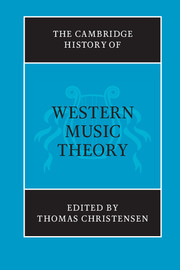Book contents
- Frontmatter
- Introduction
- PART I DISCIPLINING MUSIC THEORY
- PART II SPECULATIVE TRADITIONS
- PART III REGULATIVE TRADITIONS
- A Mapping tonal spaces
- 11 Notes, scales, and modes in the earlier Middle Ages
- 12 Renaissance modal theory: theoretical, compositional, and editorial perspectives
- 13 Tonal organization in seventeenth-century music theory
- 14 Dualist tonal space and transformation in nineteenth-century musical thought
- B Compositional Theory
- C Time
- D Tonality
- PART IV DESCRIPTIVE TRADITIONS
- Index of authors
- Index of subjects
- References
12 - Renaissance modal theory: theoretical, compositional, and editorial perspectives
from A - Mapping tonal spaces
Published online by Cambridge University Press: 28 March 2008
- Frontmatter
- Introduction
- PART I DISCIPLINING MUSIC THEORY
- PART II SPECULATIVE TRADITIONS
- PART III REGULATIVE TRADITIONS
- A Mapping tonal spaces
- 11 Notes, scales, and modes in the earlier Middle Ages
- 12 Renaissance modal theory: theoretical, compositional, and editorial perspectives
- 13 Tonal organization in seventeenth-century music theory
- 14 Dualist tonal space and transformation in nineteenth-century musical thought
- B Compositional Theory
- C Time
- D Tonality
- PART IV DESCRIPTIVE TRADITIONS
- Index of authors
- Index of subjects
- References
Summary
The word “mode” is one of the most richly textured and problematic terms of Renaissance discourse about music. The difficulties associated with interpreting modal theory are hardly recent creations: sixteenth-century writers frequently framed their discussion of modal theory with assertions that they intended to clarity a difficult concept that earlier writers had not fully grasped. Thus Pietro Aaron claimed in 1525:
And knowing [an explanation of the modes in polyphony] to be exacting and strange, I judge that it was abandoned by the celebrated musicians… not through ignorance but merely because it proved otherwise troublesome and exacting at the time. For it is clear that no writers of our age have explained how the many different modes are to be recognized … I show briefly what I know to be necessary, for I see that many are deceived about the true understanding, and regarding this I hope in some measure to satisfy them.
The central problem - a problem that Aaron appears to have been the first to articulate explicitly - hinges on the nature of the relationship to polyphony of a theory intimately tied to monophonic music in its origins. If anything, twentieth-century attempts to recover, explain, and in some cases extend, modal theory have become even more subject to contention than their sixteenth-century antecedents. Several facets of the tradition, history, and reception of the body of writings generally known as “modal theory” contribute to these difficulties. Discussions of mode appear in wide-ranging contexts that reflect antecedents in classical and ecclesiastical traditions as well as a complex, and at times contradictory, network of concepts associated with the term.
- Type
- Chapter
- Information
- The Cambridge History of Western Music Theory , pp. 364 - 406Publisher: Cambridge University PressPrint publication year: 2002
References
- 7
- Cited by

